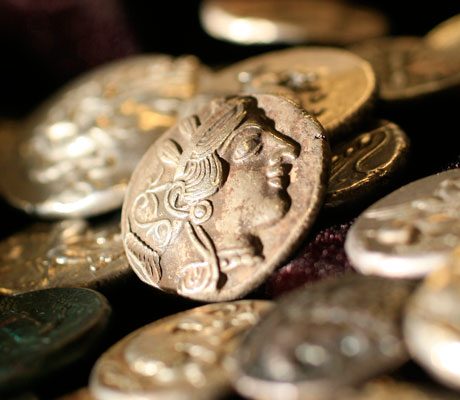Most ancient Greek coins were handmade, and were produced by striking or punching the coin design into blank pieces of metal. The engraver would first carve the designs for the front (obverse) and back (reverse) of the coin into blocks called 'dies'. Next, a soft blank metal disc was placed between the dies. The engraver would then strike the dies with a hammer, to stamp the design into the metal disc between them.

A guide to coins and coin terms
Ancient Greek Coin Names
- Drachm(a) = standard silver coin equivalent to six obols
- Hemidrachm = worth half of a drachma (from ancient Greek ἡμι- meaning ‘half’ ie. hemisphere)
- Tetradrachm = silver coin worth four drachma
- Stater = a denomination of coinage, minted in both gold and silver
Coin Terms
- Legend = the inscription on the coin, usually the name of the leader or ruler who made them
- Mint = the place of a coin’s production
- Obverse = the front of the coin (heads)
- Reverse = the back of the coin (tails)
- Type = people who study coins distinguish between 'types' according to the images on them
Dates and Times
- Archaic Period = the modern name ascribed to the period that began in approximately 600 BCE and ran until the Persian Wars in 480 BCE

- BCE = Before Common Era (ie. BC)
- CE = Common Era (ie. AD)
- ca = short for “circa” meaning 'approximately', from Latin 'around' or 'about'.
- Classical Period = the modern name ascribed to the period that began in approximately 480 BCE and lasted until around the death of Alexander III in 323 BCE
- Hellenistic = the modern name ascribed to the period of time that began with Alexander’s death and ended with Roman domination of Greece in the 1st century BCE
Greek Inscription Transliteratio
Many of the coins featured in this exhibition have 'legends' or inscriptions on them. Inscriptions could be in different languages, depending on where they were made, and are sometimes shortened to make it simpler to fit them onto the coin. Below is a selection of translations of the inscriptions on the coins featured here. The first word in each pair is the ancient Greek spelling of the inscription. The second word in each pair shows the translation in the genitive case, (which means ‘of or belonging to’), which is used for inscriptions.
ΑΛΕΧΑΝΔΡΟΣ / Alexandros
ΑΛΕΧΑΝΔΡΟΥ / Alexandrou
ΑΝΤΙΟΧΟΣ / Antiokhos
ΑΝΤΙΟΧΟΥ / Antiokhou
ΒΑΣΙΛΕΥΣ / Basileus
ΒΑΣΙΛΕΩΣ / Basileos
ΕΠΙΦΑΝΟΥΣ / Epiphanous
ΕΠΙΦΑΝΟΣ / Epiphanos
ΕΥΠΑΤΕΡ / Eupater
ΕΥΠΑΤΟΡΟΣ / Eupatoros
ΚΑΣΣΑΝΔΡΟΣ / Kassandros
ΚΑΣΣΑΝΔΡΟΥ / Kassandrou
ΛΥΣΙΜΑΧΟΣ / Lysimakhos
ΛΥΣΙΜΑΧΟΥ / Lysimakhou
ΜΕΝΑΝΔΡΟΣ / Menandros
ΜΕΝΑΝΔΡΟΥ / Menandrou
ΜΙΘΡΑΔΑΤΗΣ / Mithradates
ΜΙΘΡΑΔΑΤΟΥ / Mithradatou
ΦΙΛΙΠΠΟΣ / Philippos
ΦΙΛΙΠΠΟΥ / Philippou
ΣΕΛΕΥΚΟΣ / Seleukos
ΣΕΛΕΥΚΟΥ / Seleukou
ΣΟΤΕΡ / Soter
ΣΟΤΕΡΟΣ / Soteros
People, Places and Clothes
- Aegis = Greek symbol of divine power wielded by Zeus and Athena. A goatskin shield tasselled with snakes, with the slain head of the Gorgon Medusa set in the centre
- Achaemenids = the ruling dynasty of the Persian Empire beginning with Cyrus the Great and ending with Darius III when Alexander defeated him and claimed the Empire.
- Argeads (Ἀργεάδαι) = the ruling dynasty of Macedonia ca. 700 – 310 BCE, supposedly descended from the Arigves of the Peloponnesus.
- Chiton = standard garment of the ancient Greeks, a square of draped cloth pinned at the shoulders and belted at the waist
- Diadem = a headband worn as a sign of kingship, adopted by Alexander from the Persian Achaemenids and worn by the Hellenistic kings.
- Diadochi (Διάδοχοι) = 'successors', Alexander’s generals that competed for his Empire after his death.
- Nike = the winged goddess of Victory.
- Satrap = a local governor appointed by the Persian King to oversee a ‘satrapy’ of the Empire.
- Sinistroverse = written right to left